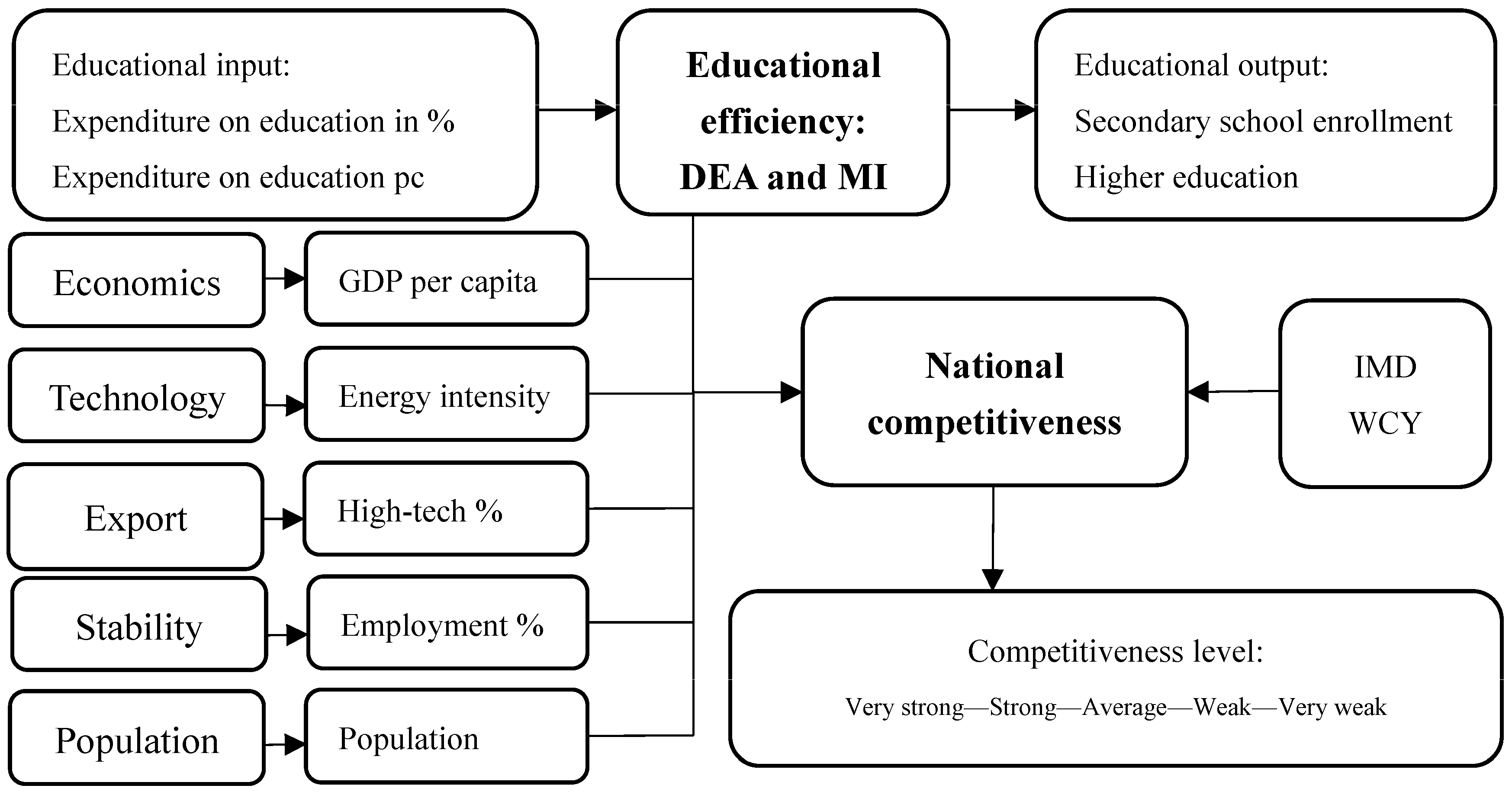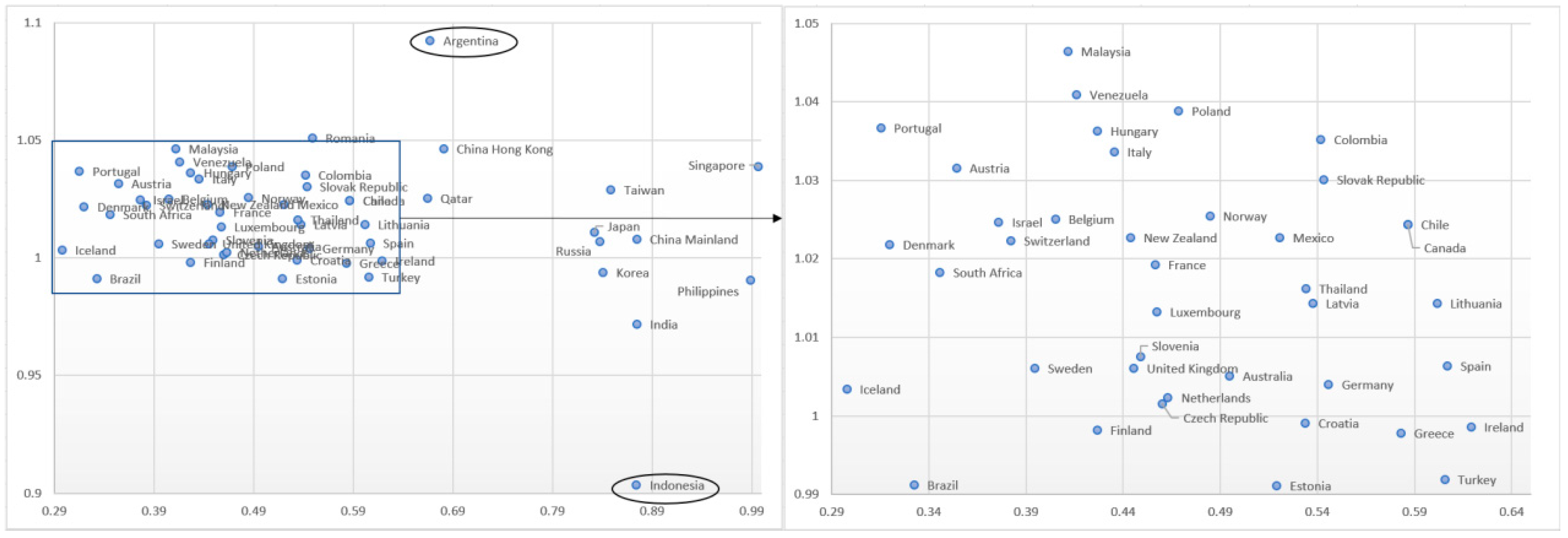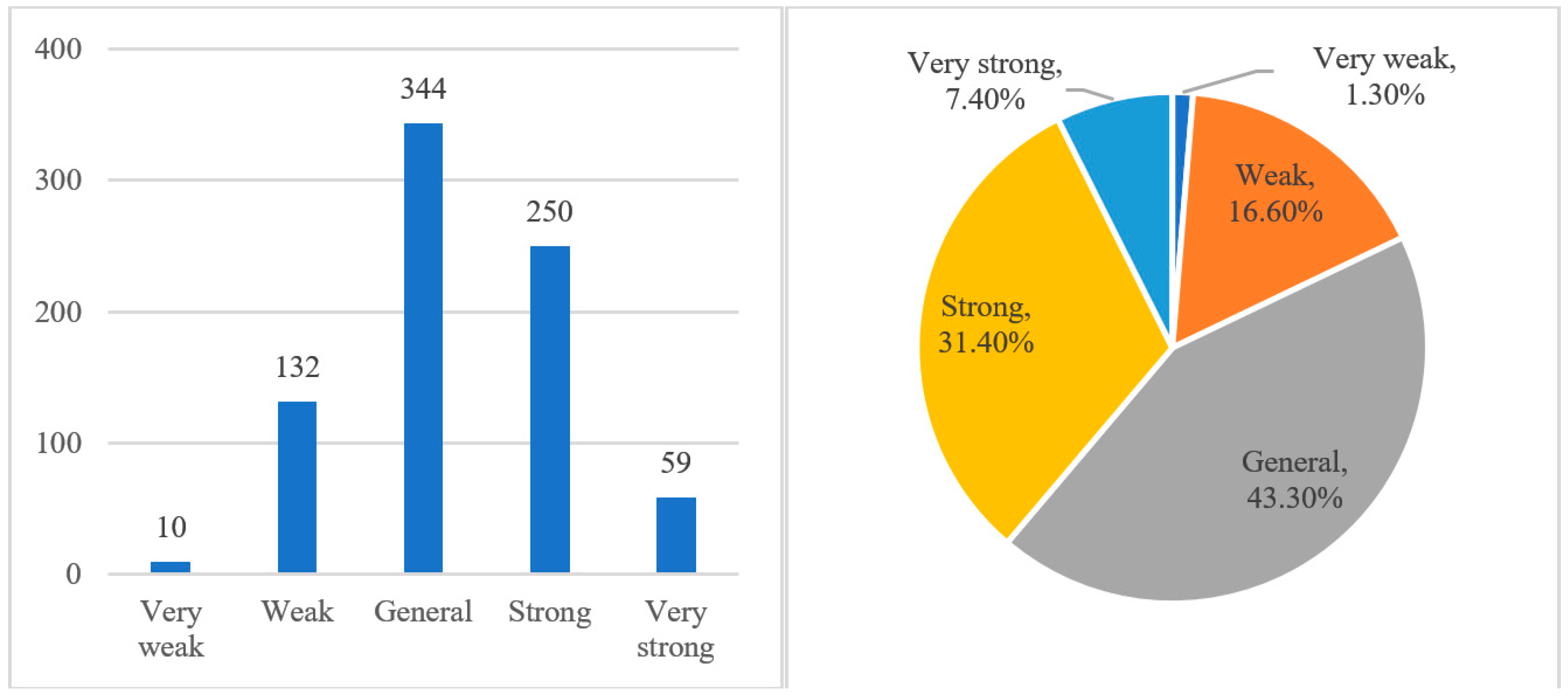Effects of Educational Efficiency on National Competitiveness Based on Cross-National Data
Abstract
:1. Introduction
2. Literature Review
3. Design and Data
3.1. Design and Methods
3.2. Data Resource
4. Results
4.1. Description of Educational Efficiency
4.2. Panel Data and Clustering Analysis
- ➢
- If national competitiveness is very strong, score ranges from 88.37 to 100 (N = 59, 7.4%).
- ➢
- If national competitiveness is strong, score ranges from 71.9 to 87.82 (N = 250, 31.4%).
- ➢
- If national competitiveness is in the general level, score ranges from 49.25 to 71.55 (N = 344, 43.3%).
- ➢
- If national competitiveness is weak, score ranges from 30.28 to 49.02 (N = 132, 16.6%).
- ➢
- If national competitiveness is very weak, the score ranges from 18.27 to 27.97 (N = 10, 1.3%).
4.2.1. Model 1: All Observations (N = 795)
4.2.2. Model 2: Countries with Very Strong National Competitiveness (N = 59)
4.2.3. Models 3 and 4: Countries with Strong (N = 250) and Average (N = 344) National Competitiveness
4.2.4. Models 5 and 6: Countries with Weak (N = 132) and Very Weak (N = 10) National Competitiveness
5. Reflections and Conclusions
Conflicts of Interest
Abbreviations
| DEA | Data Envelopment Analysis |
| MI | Malmquist Index |
| DMUs | Decision-making units |
| WEF | World Economic Forum |
| WCY | World Competitiveness Yearbook |
| IMD | International Institute for Management Development |
| EDEA | Educational efficiency |
| lnGDPpc | Ln GDP per capita |
| lnEI | Ln energy intensity |
| Hte% | High-tech exports (in %) |
| Comp | National competitiveness |
Appendix A. Single Fixed-Effect Panel

Appendix B. Two-Way Fixed-Effect Panel

References
- Draine, A. Returns from Investment in Education in a Dynamic Model of International Trade. Available online: http://blogs.bu.edu/adraine/files/2015/10/Draine2015_JMP.pdf (accessed on 13 October 2015).
- So, Soon-Hu. Efficiency Analysis of R&D Investment for Technology Development in Regional Strategic Industries using Non-Radial SBM Model. J. Ind. Econ. Bus. 2011, 24, 1169–1188. [Google Scholar]
- Lin, C.-H.; Yang, H.L.; Liou, D.Y. A cross-national comparative analysis of industrial policy and competitive advantage. Int. J. Technol. Manag. 2010, 49, 93–106. [Google Scholar] [CrossRef]
- Wu, J.X. Technology, Efficiency, Capital Accumulation and Chinese Regional Development Disparity. Quant. Tech. Econ. 2009, 26, 28–38. [Google Scholar]
- Schröder, H.; Ganzeboom, H.B.G. Measuring and Modelling Level of Education in European Societies. Eur. Sociol. Rev. 2014, 30, 119–136. [Google Scholar] [CrossRef]
- Boser, U. Return on Educational Investment: 2014. A District-by-District Evaluation of U.S. Educational Productivity; Center for American Progress: Washington, DC, USA, 2014. [Google Scholar]
- Aturupane, H. Public Investment in Education: Benefits, Challenges and Opportunities. In Decentralization and Development of Sri Lanka within a Unitary State; Springer: New York, NY, USA, 2017; pp. 179–201. [Google Scholar]
- Leiringer, R.; Cardellino, P. Schools for the twenty-first century: School design and educational transformation. Br. Educ. Res. J. 2011, 37, 915–934. [Google Scholar] [CrossRef] [Green Version]
- Xiao, J.; Zhu, X.; Jiang, B. The Research on the Use Efficiency of Educational Resource Center with the Ecological System Structure. In Proceedings of the International Conference on Intelligent Environments IEEE Computer Society, Shanghai, China, 30 June–4 July 2014; pp. 346–352. [Google Scholar]
- Liao, Q.; Li, J.; Chen, Z.J. The integrated model based on DEA method and rough set for the assessment of government efficiency. Oper. Res. Manag. Sci. 2005, 6, 14. [Google Scholar]
- Wu, H.; Zheng, C. An empirical analysis on the relative efficiency of the input-output of science and technology. Sci. Manag. Res. 2003, 3, 93–96. [Google Scholar]
- Vitezic, N.; Segota, A.; Cankar, A.A. Measuring the Efficiency of Public Health Services by DEA. Mednarodna Revija Javno Upravo 2016, 14, 27. [Google Scholar] [CrossRef]
- Cooper, W.W.; Seiford, L.M.; Tone, K. Data Envelopment Analysis: Theory, Methodology, and Applications; Kluwer Academic: Boston, MA, USA, 2000. [Google Scholar]
- Cherchye, L.; Moesen, W.; Rogge, N.; van Puyenbroeck, T. An introduction to ‘benefit of the doubt’ composite indicators. Soc. Indic. Res. 2007, 82, 111–145. [Google Scholar] [CrossRef]
- Lavado, R.F.; Cabanda, E.C. The efficiency of health and education expenditures in the Philippines. Cent. Eur. J. Oper. Res. 2009, 17, 275–291. [Google Scholar] [CrossRef]
- Park, S. Evaluating the efficiency and productivity change within government subsidy recipients of a national technology innovation research and development program. R D Manag. 2015, 45, 549–568. [Google Scholar] [CrossRef]
- Cordero-Ferrera, J.M.; Pedraja-Chaparro, F.; Salinas-Jiménez, J. Measuring efficiency in education: An analysis of different approaches for incorporating non-discretionary inputs. Appl. Econ. 2008, 40, 1323–1339. [Google Scholar] [CrossRef]
- Ofspokesperson, O. Director-general calls for sustained investment in education at thematic debate on EFA. J. Exp. Zool. 2009, 2, 473–494. [Google Scholar]
- Cohn, E. Input-Output Analysis in Public Education; Ballinger Pub. Co.: Pensacola, FL, USA, 1974. [Google Scholar]
- Goodman, H.H. The Concept of Output in Education. Educ. Forum 1979, 44, 71–82. [Google Scholar] [CrossRef]
- Hough, J.R. Input-output analysis in education in the U.K.—Review Essay. Econ. Educ. Rev. 1991, 10, 73–81. [Google Scholar] [CrossRef]
- Geva-May, I. Higher education and attainment of policy goals: Interpretations for efficiency indicators in Israel. High. Educ. 2001, 42, 265–305. [Google Scholar] [CrossRef]
- Katharaki, M.; Katharakis, G. A comparative assessment of Greek universities’ efficiency using quantitative analysis. Int. J. Educ. Res. 2010, 49, 115–128. [Google Scholar] [CrossRef]
- Johnes, J. Data envelopment analysis and its application to the measurement of efficiency in higher education. Econ. Educ. Rev. 2006, 25, 273–288. [Google Scholar] [CrossRef]
- Campbell, R.E. A review article on advances in educational productivity volume I: The evaluation of educational efficiency: Constraints, issues, and policies edited by Herbert J. Walberg. Asian Econ. J. 2010, 6, 317–322. [Google Scholar] [CrossRef]
- Bursalioglu, S.A.; Selim, S. Factors Determining the Efficiency of Higher Education in the European Union and Turkey. BILIG 2015, 74, 45–69. [Google Scholar]
- Lassibille, G.; Navarro Gómez, L.U.C.Í. Organization and Efficiency of Education Systems: Some empirical findings. Comp. Educ. 2000, 36, 7–19. [Google Scholar] [CrossRef]
- Grosskopf, S.; Hayes, K.J.; Taylor, L.L. Efficiency in Education: Research and Implications. Appl. Econ. Perspect. Policy 2014, 36, 175–210. [Google Scholar] [CrossRef]
- Bates, J.M. Measuring predetermined socioeconomic “inputs” when assessing the efficiency of educational outputs. Appl. Econ. 1997, 29, 85–93. [Google Scholar] [CrossRef]
- Casalprim, M.; Rialp, J.; Prior, D.; Sabrià, B. An assessment of schools’ efficiency of different educational systems. Mediterr. J. Soc. Sci. 2013, 4, 631–639. [Google Scholar] [CrossRef]
- Chang, T.Y.; Chung, P.H.; Hsu, S.S. Two-stage performance model for evaluating the managerial efficiency of higher education: Application by the Taiwanese tourism and leisure department. J. Hosp. Leis. Sport Tour. Educ. 2012, 11, 168–177. [Google Scholar] [CrossRef]
- Aristovnik, A.; Obadić, A. Measuring relative efficiency of secondary education in selected EU and OECD countries: The case of Slovenia and Croatia. Technol. Econ. Dev. Econ. 2014, 20, 419–433. [Google Scholar] [CrossRef]
- Tsamadias, C.; Kyratzi, P. Efficiency and productivity of Greek higher technological educational institutions: An assessment over the period 2005–2009. Int. J. Educ. Econ. Dev. 2014, 5, 241–256. [Google Scholar] [CrossRef]
- Mu, R.; Ren, Z.; Song, H.; Chen, F. Innovative development and innovation capacity-building in China. Int. J. Technol. Manag. 2010, 51, 427–452. [Google Scholar] [CrossRef]
- Shriberg, M. Institutional assessment tools for sustainability in higher education: Strengths, weaknesses, and implications for practice and theory. High. Educ. Policy 2002, 15, 153–167. [Google Scholar] [CrossRef]
- Wals, A.E.J.; Jickling, B. “sustainability” in higher education: From doublethink and newspeak to critical thinking and meaningful learning. High. Educ. Policy 2002, 15, 121–131. [Google Scholar] [CrossRef]
- Ives, B. Education: A sustainable national competitive advantage. MIS Q. 1992, 16, 43–54. [Google Scholar]
- Weibust, P.S. Education’s Role in National Development Plans: Ten Country Cases; Thomas, R.M., Ed.; Greenwood Publishing Group: Westport, CT, USA, 1992; Volume 37, p. 295. [Google Scholar]
- Sahlberg, P.J. Education Reform for Raising Economic Competitiveness. J. Educ. Chang. 2006, 7, 259–287. [Google Scholar] [CrossRef]
- Ross, A.M. Education and national development. Sci. Educ. 2010, 68, 563–569. [Google Scholar]
- Ramoniene, L.; Lanskoronskis, M. Reflection of higher education aspects in the conception of national competitiveness. Balt. J. Manag. 2011, 6, 124–139. [Google Scholar] [CrossRef]
- IMD World Competitiveness Center. IMD World Competitiveness Yearbook 2016; Institute for Management Development (IMD): Lausanne, Switzerland, 2016. [Google Scholar]
- Ott, J. World Bank World Development Indicators; Springer: New York, NY, USA, 2014. [Google Scholar]
- Boateng, N.A. Does public expenditure management matter for education outcomes? Dev. South. Afr. 2014, 31, 535–552. [Google Scholar] [CrossRef]
- Neycheva, M.; Joensen, K. Higher educational attainment for growth: The MRW model for Iceland. Scand. J. Educ. Res. 2017, 1–16. [Google Scholar] [CrossRef]
- Tao, A. Research on relationship between energy consumption quality and education, science and technology based on grey relation theory. Energy Procedia 2011, 5, 1718–1721. [Google Scholar]
- Duro, J.A.; Alcántara, V.; Padilla, E. International inequality in energy intensity levels and the role of production composition and energy efficiency: an analysis of OECD countries. Ecol. Econ. 2010, 69, 2468–2474. [Google Scholar] [CrossRef]
- Srholec, M. High-tech exports from developing countries: A symptom of technology spurts or statistical illusion? Rev. World Econ. 2007, 143, 227–255. [Google Scholar] [CrossRef]
- Pigou, A.C. Some Considerations on Stability Conditions, Employment and Real Wage Rates. Econ. J. 1945, 55, 346–356. [Google Scholar] [CrossRef]
- Knack, S.; Azfar, O. Trade intensity, country size and corruption. Econ. Gov. 2003, 4, 1–18. [Google Scholar] [CrossRef]
- Mayor, G.O.; Davó, N.B.; Hera, M.L.B.D.L. Technological innovation as a determining factor on national competitiveness. Rev. Econ. Mund. 2012, 67, 137–166. [Google Scholar]



| Model 1 | Model 2 | Model 3 | Model 4 | Model 5 | Model 6 | |
|---|---|---|---|---|---|---|
| Competitiveness | All observations | Very strong | Strong | Average | Weak | Very weak |
| Educational efficiency | −0.041 (1.882) | 0.506 ** (2.198) | −0.115 (1.681) | 0.029 (1.704) | −1.536 (24.100) | −0.050 (2.099) |
| GDP per capita | 0.404 ** (0.973) | −0.025 (3.169) | 0.383 ** (0.987) | 0.347 ** (0.870) | 2.139 (16.520) | 0.148 (1.299) |
| Energy intensity | −0.161 ** (0.828) | −0.586 ** (0.861) | 0.009 (0.616) | 0.110 (0.853) | 0.782 (12.027) | −0.214 (1.009) |
| High-tech exports (%) | 0.274 ** (0.027) | −0.064 (0.035) | 0.212 ** (0.025) | 0.144 ** (0.025) | 0.892 (0.381) | 0.232 (0.042) |
| Employment (%) | 0.348 ** (0.055) | 0.180 (0.161) | 0.223 ** (0.041) | 0.230 ** (0.057) | 0.935 (0.358) | 0.107 (0.083) |
| Population market size | 0.042 (0.278) | −0.088 (0.489) | 0.005 (0.222) | 0.073 (0.230) | 1.852 (4.175) | 0.035 (0.403) |
| R2adj | 0.639 | 0.308 | 0.199 | 0.135 | 0.377 | 0.081 |
| N | 795 | 59 | 250 | 344 | 132 | 10 |
© 2017 by the authors. Licensee MDPI, Basel, Switzerland. This article is an open access article distributed under the terms and conditions of the Creative Commons Attribution (CC BY) license (http://creativecommons.org/licenses/by/4.0/).
Share and Cite
Liu, F.; Xu, H. Effects of Educational Efficiency on National Competitiveness Based on Cross-National Data. Educ. Sci. 2017, 7, 81. https://doi.org/10.3390/educsci7040081
Liu F, Xu H. Effects of Educational Efficiency on National Competitiveness Based on Cross-National Data. Education Sciences. 2017; 7(4):81. https://doi.org/10.3390/educsci7040081
Chicago/Turabian StyleLiu, Fangtao, and Huan Xu. 2017. "Effects of Educational Efficiency on National Competitiveness Based on Cross-National Data" Education Sciences 7, no. 4: 81. https://doi.org/10.3390/educsci7040081





